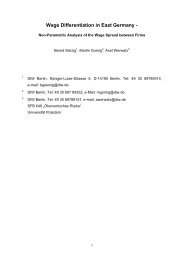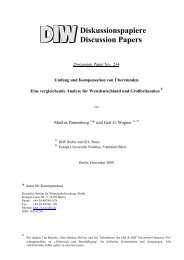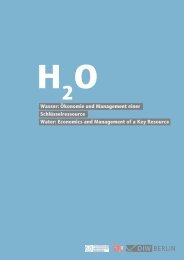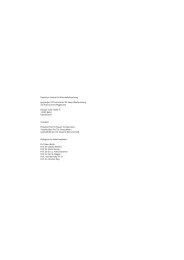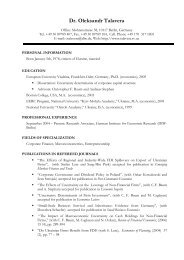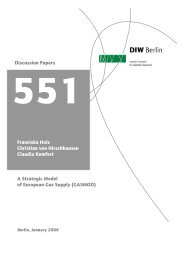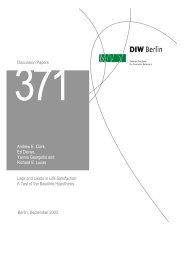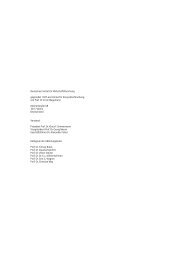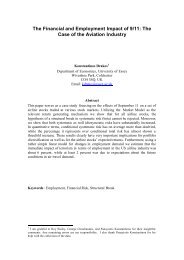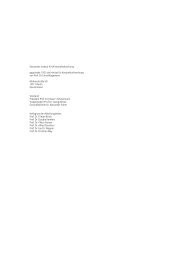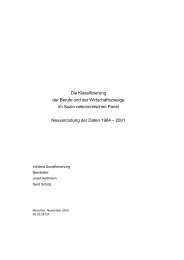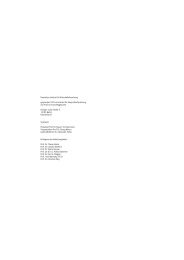Holger Görg and Frederic Warzynski Price cost margins ... - DIW Berlin
Holger Görg and Frederic Warzynski Price cost margins ... - DIW Berlin
Holger Görg and Frederic Warzynski Price cost margins ... - DIW Berlin
You also want an ePaper? Increase the reach of your titles
YUMPU automatically turns print PDFs into web optimized ePapers that Google loves.
1 Introduction<br />
Theissueofwhetherfirms that export have productivity advantages over<br />
non-exporters has been the subject of much research <strong>and</strong> debate recently.<br />
Evidence showing such a productivity advantage is plentiful, see, for example,<br />
the papers by Clerides et al. (1998) for Colombia, Mexico <strong>and</strong> Morocco,<br />
Bernard <strong>and</strong> Jensen (1999) for the US, Girma et al. (2003) for the UK <strong>and</strong><br />
Hallward-Driemeier et al. (2002) for a number of East Asian countries. 1 A<br />
related question that comes to mind is whether this apparent productivity<br />
advantage also has an effect on the competitiveness of exporters compared<br />
to non-exporters. To be more precise, are exporters that have an apparent<br />
productivity advantage also able to sustain higher price <strong>cost</strong> <strong>margins</strong> than<br />
non-exporters? This question, which does not appear to have been addressed<br />
in the existing literature, is the topic of this paper.<br />
If markets are less than perfectly competitive firms are able to charge<br />
prices higher than marginal <strong>cost</strong>, i.e., their mark-up defined as the ratio of<br />
price over marginal <strong>cost</strong> (p/mc) will be greater than one. The evidence that<br />
mark-ups exist is widespread (e.g., Hall, 1988, Roeger, 1995, Konings et al.,<br />
2001) <strong>and</strong> is taken as evidence that competition is less than perfect. Much<br />
has been written about the effect of import competition on mark-ups <strong>and</strong><br />
this literature has recently been reviewed by Tybout (2001). Trade theoretic<br />
models (e.g., Krugman, 1979, Br<strong>and</strong>er, 1981) show that a move from autarky<br />
to free trade will lead to increases in output through imports, resulting in<br />
stronger competition <strong>and</strong> hence reductions in the mark-up. Empirical studies<br />
that look at the link between import competition <strong>and</strong> mark-ups are provided<br />
by, for example, Levinsohn (1993), Harrison (1994), Katics <strong>and</strong> Petersen<br />
(1994), Krishna <strong>and</strong> Mitra (1998) <strong>and</strong> Co (2001). These studies generally<br />
find that increases in imports, or reductions in trade protection, are related<br />
with decreasing mark-ups.<br />
This paper examines the trade - competition link from a slightly different<br />
point of view. We investigate empirically whether exporting activity is<br />
related to firms’ price <strong>cost</strong> <strong>margins</strong>.<br />
Bernard et al. (2003) have recently provided a model based on imperfect<br />
competition that links firm level efficiency, firm specific mark-ups <strong>and</strong><br />
exporting activity of a firm in a consistent way. In imperfectly competi-<br />
1 Much of the recent debate focusses on whether firms learn through exporting (e.g.,<br />
Girma et al. 2003a) or whether more productive firms self select into exporting (e.g.,<br />
Bernard <strong>and</strong> Jensen, 1999 <strong>and</strong> Clerides et al. 1998).<br />
2



